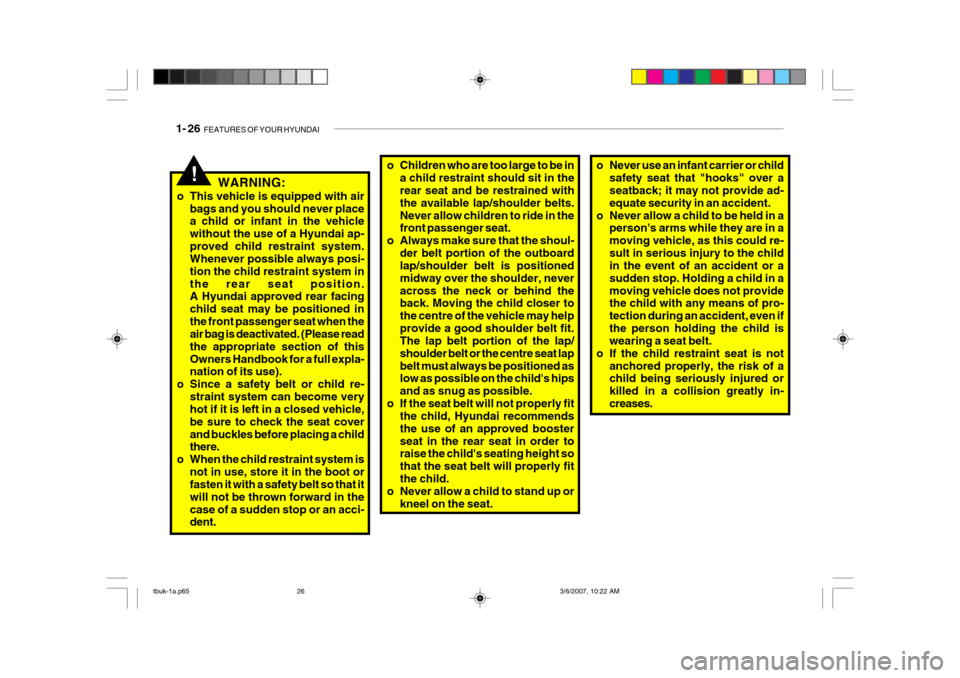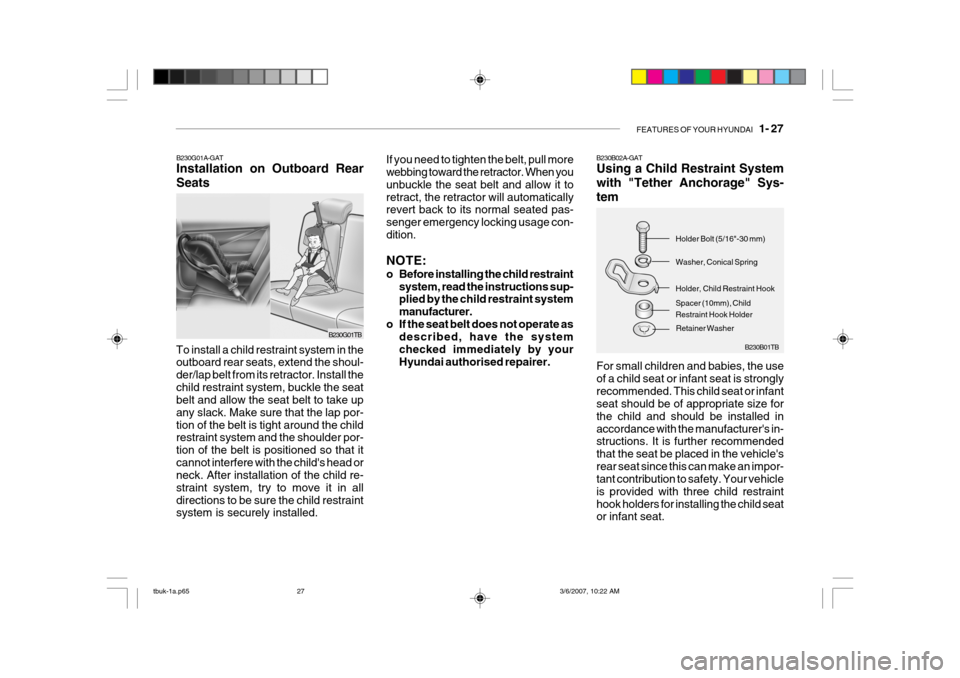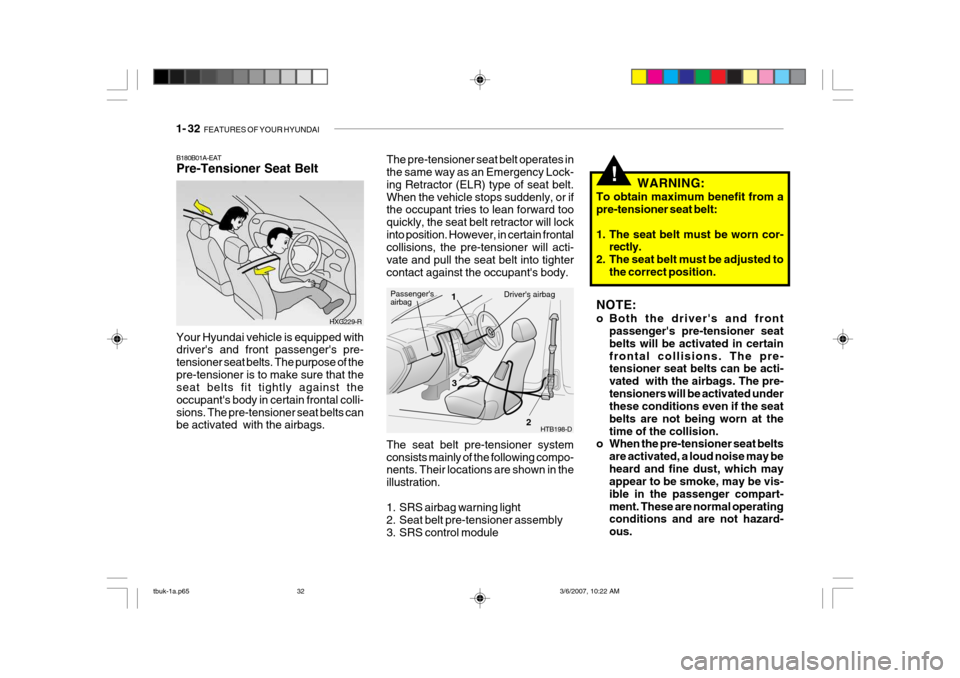2006 Hyundai Getz belt
[x] Cancel search: beltPage 283 of 455

1- 26 FEATURES OF YOUR HYUNDAI
o Children who are too large to be in
a child restraint should sit in the rear seat and be restrained with the available lap/shoulder belts.Never allow children to ride in the front passenger seat.
o Always make sure that the shoul-
der belt portion of the outboardlap/shoulder belt is positioned midway over the shoulder, neveracross the neck or behind the back. Moving the child closer to the centre of the vehicle may helpprovide a good shoulder belt fit. The lap belt portion of the lap/ shoulder belt or the centre seat lapbelt must always be positioned as low as possible on the child's hips and as snug as possible.
o If the seat belt will not properly fit the child, Hyundai recommendsthe use of an approved boosterseat in the rear seat in order to raise the child's seating height so that the seat belt will properly fitthe child.
o Never allow a child to stand up or
kneel on the seat. o Never use an infant carrier or child
safety seat that "hooks" over a seatback; it may not provide ad- equate security in an accident.
o Never allow a child to be held in a person's arms while they are in amoving vehicle, as this could re-sult in serious injury to the child in the event of an accident or a sudden stop. Holding a child in amoving vehicle does not provide the child with any means of pro- tection during an accident, even ifthe person holding the child is wearing a seat belt.
o If the child restraint seat is not anchored properly, the risk of achild being seriously injured or killed in a collision greatly in-creases.
WARNING:
o This vehicle is equipped with air bags and you should never place a child or infant in the vehicle without the use of a Hyundai ap-proved child restraint system. Whenever possible always posi- tion the child restraint system inthe rear seat position. A Hyundai approved rear facing child seat may be positioned inthe front passenger seat when the air bag is deactivated. (Please read the appropriate section of thisOwners Handbook for a full expla- nation of its use).
o Since a safety belt or child re- straint system can become veryhot if it is left in a closed vehicle, be sure to check the seat coverand buckles before placing a child there.
o When the child restraint system is not in use, store it in the boot orfasten it with a safety belt so that it will not be thrown forward in thecase of a sudden stop or an acci- dent.!
tbuk-1a.p65 3/6/2007, 10:22 AM
26
Page 284 of 455

FEATURES OF YOUR HYUNDAI 1- 27
If you need to tighten the belt, pull more webbing toward the retractor. When you unbuckle the seat belt and allow it toretract, the retractor will automatically revert back to its normal seated pas- senger emergency locking usage con-dition. NOTE:
o Before installing the child restraint
system, read the instructions sup- plied by the child restraint system manufacturer.
o If the seat belt does not operate as described, have the systemchecked immediately by yourHyundai authorised repairer.
B230B01TB
B230B02A-GAT Using a Child Restraint System with "Tether Anchorage" Sys-tem For small children and babies, the use of a child seat or infant seat is stronglyrecommended. This child seat or infant seat should be of appropriate size for the child and should be installed inaccordance with the manufacturer's in- structions. It is further recommended that the seat be placed in the vehicle'srear seat since this can make an impor- tant contribution to safety. Your vehicle is provided with three child restrainthook holders for installing the child seat or infant seat. Spacer (10mm), Child Restraint Hook Holder
Holder Bolt (5/16"-30 mm) Washer, Conical Spring Holder, Child Restraint Hook
Retainer Washer
To install a child restraint system in the outboard rear seats, extend the shoul- der/lap belt from its retractor. Install thechild restraint system, buckle the seat belt and allow the seat belt to take up any slack. Make sure that the lap por-tion of the belt is tight around the child restraint system and the shoulder por- tion of the belt is positioned so that itcannot interfere with the child's head or neck. After installation of the child re- straint system, try to move it in alldirections to be sure the child restraint system is securely installed.B230G01A-GAT Installation on Outboard Rear Seats
B230G01TB
tbuk-1a.p65
3/6/2007, 10:22 AM
27
Page 286 of 455

FEATURES OF YOUR HYUNDAI 1- 29
On each side of the rear seat, between the cushion and backrest, are located a pair of ISOFIX anchorage points to-gether with a top tether mounting on the luggage compartment. During the in- stalling, the seat has to be engaged atthe anchorage-points in a way you can hear it clicking (check by pulling!) and has to be fixed with the Top Tether-belton the belonging point in the luggage- compartment. The installing and the use of a child-seat has to be doneaccording to the installing-manual, which is added to the ISOFIX-seat. NOTE: An ISOFIX-child-seat can only be installed if the seat has a vehicle- specific approval according to ECE-R44. Before using the ISOFIX-child- seat, which was bought for another car, ask your Hyundai-dealer whetherthis seat-type is approved and rec- ommended for your Hyundai.
An ISOFIX-seat can only be installed if it has vehicle-specific approval in ac-cordance with the requirements of ECE- R44. For your Hyundai, the Hyundai ISOFIX GR1 / Hyundai Duo / RömerISOFIX GR1 and the Römer Duo ISOFIX / Britax Duo ISOFIX is approved ac- cording to the requirement ECE-R44.This seat has been tested extensively by Hyundai and is recommended for your Hyundai.
B230C01TB
ISOFIX Anchor
ISOFIX Anchor Indicator Button
B230D04E-EAT Using a Child Restraint System with "ISOFIX" System and"Tether Anchorage" System ISOFIX is a standardised method of fitting child seats that eliminates the need to use the standard adult seat beltto secure the seat in the vehicle. This enables a much more secure and posi- tive location with the added benefit ofeasier and quicker installation.
HTB193
tbuk-1a.p65
3/6/2007, 10:22 AM
29
Page 287 of 455

1- 30 FEATURES OF YOUR HYUNDAI
!WARNING:
o Do not install a child restraint seat at the center of the rear seat using the vehicle's ISOFIX anchors. The ISOFIX anchors are only provided for the left and right outboard rearseating positions. Do not misuse the ISOFIX anchors by attempting to attach a child restraint seat inthe middle of the rear seat to the ISOFIX anchors. In a crash, the child restraint seat ISOFIX attach-ments may not be strong enough to secure the child restraint seat properly in the center of the rear seat and may break, causing seri- ous injury or death.
o When using the vehicle’s “ISOFIX” system to install a child restraintsystem in the rear seat, all unusedvehicle rear seat belt metal latch plates or tabs must be latched securely in their seat belt bucklesand the seat belt webbing must be retracted behind the child restraint to prevent the child from reachingand taking hold of unretracted seat belts.
B230C02TB
1. To engage the child restraint seat to the ISOFIX anchor, insert the child restraint seat latch into the ISOFIX anchor. Listen for the audible "click"sound.
2. Connect the tether strap hook to the
child restraint hook holder and tightento secure the seat. Refer to "Secur- ing a Child Restraint System with the Tether Anchorage System" on page1-27.
To secure the child restraint seat
o Do not mount more than one child
restraint to a child restraint lower anchorage point. The improper increased load may cause the an- chorage points or tether anchor tobreak, causing serious injury or death.
o Attach the ISOFIX or ISOFIX-com-
patible child restraint seat only tothe appropriate locations shown in the illustration.
o Always follow the installation and use instructions provided by themanufacturer of the child restraint.
tbuk-1a.p65 3/6/2007, 10:22 AM
30
Page 289 of 455

1- 32 FEATURES OF YOUR HYUNDAI
!WARNING:
To obtain maximum benefit from a pre-tensioner seat belt:
1. The seat belt must be worn cor- rectly.
2. The seat belt must be adjusted to the correct position.
NOTE:
o Both the driver's and front passenger's pre-tensioner seat belts will be activated in certainfrontal collisions. The pre- tensioner seat belts can be acti- vated with the airbags. The pre-tensioners will be activated under these conditions even if the seat belts are not being worn at thetime of the collision.
o When the pre-tensioner seat belts
are activated, a loud noise may beheard and fine dust, which may appear to be smoke, may be vis- ible in the passenger compart-ment. These are normal operating conditions and are not hazard- ous.
B180B01A-EAT Pre-Tensioner Seat Belt
HXG229-R
Your Hyundai vehicle is equipped with driver's and front passenger's pre- tensioner seat belts. The purpose of thepre-tensioner is to make sure that the seat belts fit tightly against the occupant's body in certain frontal colli-sions. The pre-tensioner seat belts can be activated with the airbags.The pre-tensioner seat belt operates in the same way as an Emergency Lock- ing Retractor (ELR) type of seat belt.When the vehicle stops suddenly, or if the occupant tries to lean forward too quickly, the seat belt retractor will lockinto position. However, in certain frontal collisions, the pre-tensioner will acti- vate and pull the seat belt into tightercontact against the occupant's body. The seat belt pre-tensioner system consists mainly of the following compo- nents. Their locations are shown in the illustration.
1. SRS airbag warning light
2. Seat belt pre-tensioner assembly
3. SRS control module HTB198-D
Driver's airbag1
2
3Passenger's airbag
tbuk-1a.p65
3/6/2007, 10:22 AM
32
Page 290 of 455

FEATURES OF YOUR HYUNDAI 1- 33
o Do not strike the pre-tensioner seat
belt assemblies.
o Do not attempt to service or re- pairer the pre-tensioner seat belt system in any manner.
o Improper handling of the pre- tensioner seat belt assemblies, andfailure to heed the warnings to notstrike, modify, inspect, replace, service or repairer the pre- tensioner seat belt assemblies maylead to improper operation or in- advertent activation and serious injury.
o Always wear the seat belts when driving or travelling in a motorvehicle.
!
o Although it is harmless, the finedust may cause skin irritation and should not be breathed for pro-longed periods. Wash your hands and face thoroughly after an acci- dent in which the pre-tensionerseat belts were activated. or if it illuminates whilst the ve- hicle is being driven, please have a Hyundai authorised repairer in-spect the pre-tensioner seat belt or SRS airbag system as soon as possible.
CAUTION:
o Because the sensor that activates the SRS airbag is connected with the pre-tensioner seat belt, the SRS airbag warning light on theinstrument panel will blink for approximately 6 seconds after the ignition key has been turned to the "ON" position and then it should turn off.
o If the pre-tensioner seat belt is not working properly, this warninglight will illuminate even if theSRS system is not functioning. If the SRS airbag warning light does not illuminate when the igni-tion key is turned to "ON", or if it remains illuminated after blinking for approximately 6 seconds, WARNING:
o Pre-tensioners are designed to op- erate only one time. After activa- tion, pre-tensioner seat belts must be replaced. All seat belts, of any type, should always be replaced after they have been worn during acollision.
o The pre-tensioner seat belt assem-
bly mechanisms become hot dur-ing activation. Do not touch the pre-tensioner seat belt assemblies for several minutes after they havebeen activated.
o Do not attempt to inspect or re-
place the pre-tensioner seat beltsyourself. This must be done by a Hyundai authorised repairer.
!
tbuk-1a.p65 3/6/2007, 10:22 AM
33
Page 291 of 455

1- 34 FEATURES OF YOUR HYUNDAI
HTB203
Rear impact
Side Impact Rollover
o The SRS is designed to deploy the
airbags only when an impact is sufficiently severe and when theimpact angle is less than 30° from the forward longitudinal axis of the vehicle and will not deploy inside, rear or rollover impacts. Additionally, the airbags will only deploy once. Thus, seat belts mustbe worn at all times.
o Front airbags are not intended to deploy in side-impact, rear-impactor rollover crashes. In addition, airbags will not normally deploy in frontal crashes below the de-ployment threshold speed.
!
B240B01TB
Driver's Airbag
Your Hyundai is equipped with a Supple- mental Restraint (Airbag) System. The indications of the system's presenceare the letters "SRS AIR BAG" em- bossed on the airbag pad cover in the steering wheel and printed on thepassenger's side front panel pad above the glove box. The Hyundai SRS consists of airbags installed under the pad covers in the centre of the steering wheel and thepassenger's side front panel above the glove box. The purpose of the SRS is to provide the vehicle's driver and/or thefront passenger with additional protec- B240A01TB-EAT SUPPLEMENTAL RESTRAINT (AIRBAG) SYSTEM
tion than that offered by the seat belt system alone, in case of a frontal im- pact of sufficient severity. NOTE: Be sure to read information about the SRS on the labels provided onthe back of the sun visor and in the glove box.
WARNING:
o As its name implies, the SRS is designed to work with, and besupplemental to, the driver's and the passenger's three point seatbelt systems and is not a substi- tute for them. Therefore your seat belts must be worn at all timeswhile the vehicle is in motion. In addition, the airbags deploy only in certain frontal impact condi-tions severe enough to likely cause significant injury to the vehicle occupants.
tbuk-1a.p65 3/6/2007, 10:22 AM
34
Page 292 of 455

FEATURES OF YOUR HYUNDAI 1- 35
The SRS service reminder indicator (SRI) on the instrument panel will blinkfor approimately 6 seconds after the ignition key is turned to the "ON" posi- tion or after the engine is started, afterwhich the SRI should go out.
B240B02L-D
o For maximum safety protection in
all types of crashes, all occupants including the driver should always wear their seat belts whether ornot an airbag is also provided at their seating position to minimize the risk of severe injury or death inthe event of a crash. Do not sit or lean unnecessarily close to the airbag while the vehicle is in mo-tion.
o The SRS airbag system must de-
ploy very rapidly to provide pro-tection in a crash. If an occupant is out of position because of not wearing a seat belt, the airbag mayforcefully contact the occupant causing serious or fatal injuries.
The SRS consists of the following com- ponents:
- Driver's Airbag Module
- Passenger's Airbag Module
- SRS Service Reminder Indicator(SRI)
- SRS Control Module (SRSCM) The SRSCM continually monitors all elements while the ignition is "ON" to determine if a frontal or near-frontalimpact is severe enough to require airbag deployment.
B240B03A-DAT SRS Components and Functions
B240B01L-D
tbuk-1a.p65
3/6/2007, 10:22 AM
35